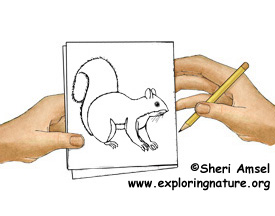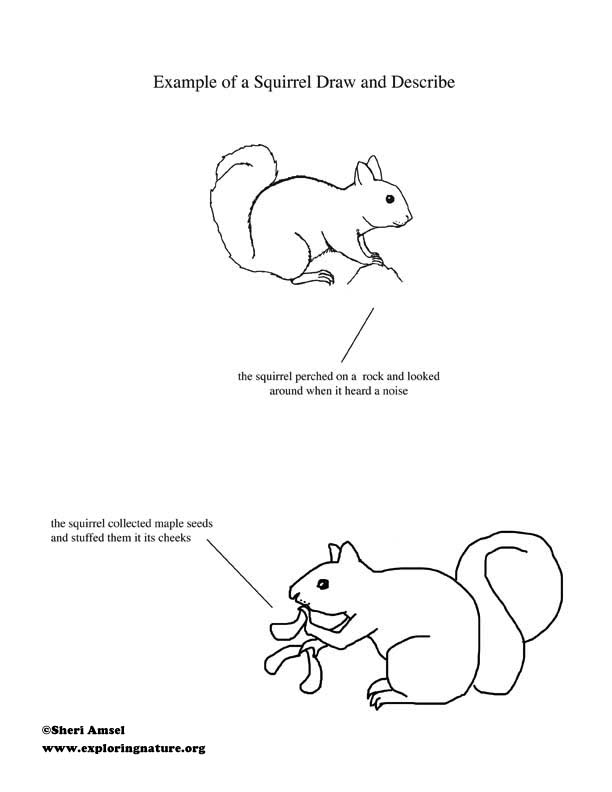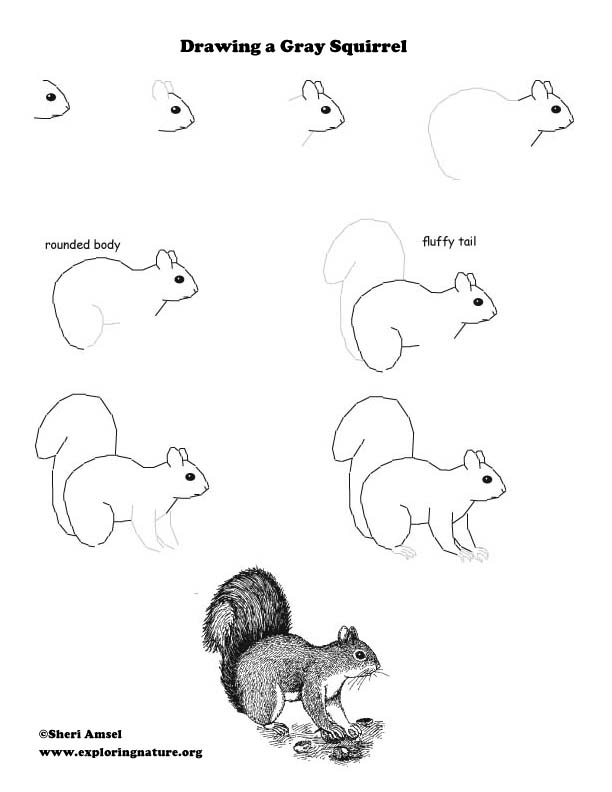

Objectives: Watching squirrels on a regular basis to record what they do and how they interact with other squirrels, animals and people.
Materials: A journal (small spiral notebook or sketch pad), pencil, watch to keep track of time. (If watching from a sunny place, wear a hat and sunscreen.)
Procedures:
1) Ask some questions and make some hypothesis (ideas). For example, Question: Why do squirrels chatter? Hypothesis: To scare away intruders? Or Question: Why do squirrels cross roads? Hypothesis: For better food collection? Or Question: Do squirrels live alone or in groups? Hypothesis: In groups? Or Question: What foods do squirrels like best? Hypothesis: Acorns?
2) Find a tree where squirrels regularly live near your house. Sit on the ground about 25 feet away and watch them quietly for 15 minutes, at the same time of day, 2-3 times a week. Try not ot make sudden moves or noise to frighten them. You can watch them longer -- more than once a day and/or more days a week, but make sure you watch them for at least 15 minutes each time. Be sure to write down the date and time of each observation.
3) Record what the squirrels are doing. Describe how they sit, how they act toward each other, what things scare them, what things they ignore, what foods they collect, where they take the food, what makes them chatter, is their chatter different for different things, do they get more used to you after a few days, if there are more than one, can you tell the squirrels apart, do they each act differently, do they act differently at different times of the day?
4) Draw and describe the squirrels. Draw how they sit when they eat, watch, chatter, move, interact with other squirrels. Make notes under your drawing so you can remember later what they were doing. Practice drawing squirrels with the instructional sheet to make study drawings easier. See the "Draw and Describe" page for an example of how to make entries in journal about the squirrels' behavior.
5) At the end of the summer, read over your notes and make comparisons. Note patterns. Note changes over time. Record what things surprized you. Did you answer any of the questions you asked at the beginning of the summer? Did this project make you think differently about squirrels? Do you notice squirrels and other animals more now?
3. Life Science Standards
Science subject matter focuses on the science facts, concepts, principles, theories, and models that are important for all students to know, understand, and use.
K-4 Characteristics of Organisms, life cycles of organisms, organisms and environments
5-8 Structure and function in living systems, reproduction and heredity, regulation and behavior, populations and ecosystems, diversity and adaptations of organisms
When you research information you must cite the reference. Citing for websites is different from citing from books, magazines and periodicals. The style of citing shown here is from the MLA Style Citations (Modern Language Association).
When citing a WEBSITE the general format is as follows.
Author Last Name, First Name(s). "Title: Subtitle of Part of Web Page, if appropriate." Title: Subtitle: Section of Page if appropriate. Sponsoring/Publishing Agency, If Given. Additional significant descriptive information. Date of Electronic Publication or other Date, such as Last Updated. Day Month Year of access < URL >.
Amsel, Sheri. "Animal Behavior Study for Kids - Watching Squirrels" Exploring Nature Educational Resource ©2005-2024. December 13, 2024
< http://www.exploringnature.org/db/view/Animal-Behavior-Study-for-Kids-Watching-Squirrels >


